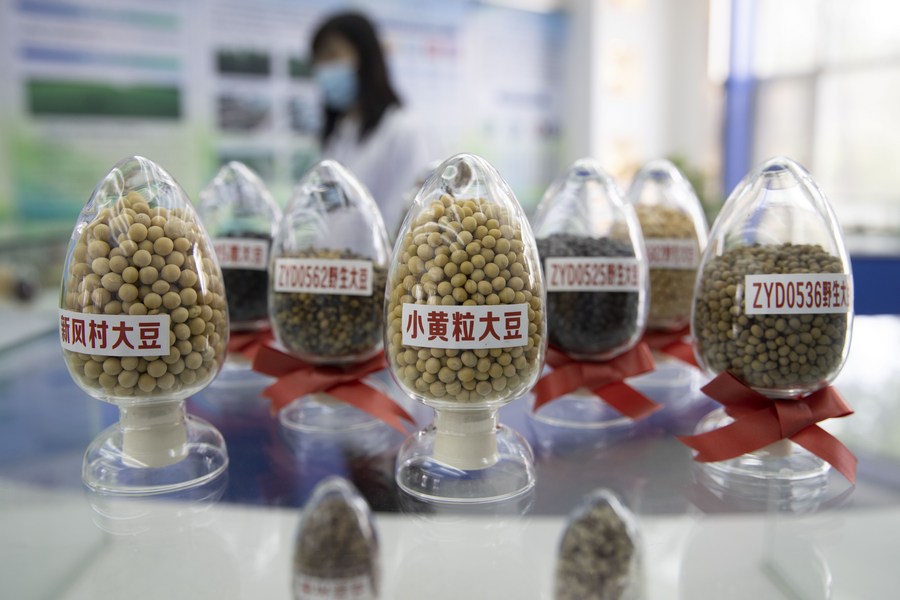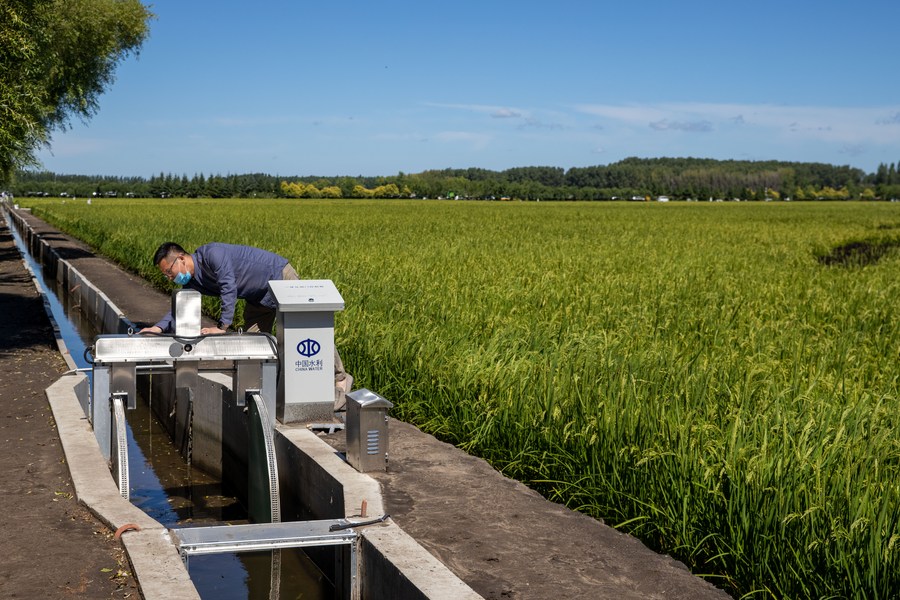How China's breadbasket province ensures grain output through new technologies
* Heilongjiang, a region known as China's "grain barn," accounts for more than 40 percent of the country's total soybean planting area.
* The province's soybean output is estimated to hit 8.5 billion kg this year, about 1.3 billion kg more than last year.
* From seed breeding to the protection of black soil and the promotion of mechanical and digital farming, a great deal of innovative science and technology has been applied in Heilongjiang to promote the rapid development of modern agriculture.
HARBIN -- The grain production cycle between March and September is usually the busiest time of the year for agronomist Li Yanhua.
Li, who works with the Northeast Institute of Geography and Agroecology, Chinese Academy of Sciences, is the brain behind a number of popular soybean varieties grown in China.

Soybean seeds are pictured at a seed bank for cold-region crops in northeast China's Heilongjiang Province, May 19, 2022. [Xinhua/Zhang Tao]
During these hectic months, she monitors the planting and growing process of soybean which involves seed selection and artificial pollination research.
When the temperature drops in northeast China's Heilongjiang Province, where the research institute is located, Li would transport her plants to the southernmost tropical province of Hainan to help accelerate the breeding process.
"Premium seeds are a prerequisite for growing quality grain. It usually takes 10 years to breed a new variety of grain before putting it on the market," Li said.
Bags of soybean seeds are labeled and arranged on grids in the cabinets of her laboratory. The "Dongsheng" series of soybean developed by Li have become popular in Heilongjiang, a region known as China's "grain barn," which accounts for more than 40 percent of the country's total soybean planting area.
Due to their high oil content, high protein content, and lodging resistance, the "Dongsheng" series are in high demand after farmers saw promising output potential.
Du Zhentao, chairman of a pilot modern agricultural cooperative in Hailun City, Heilongjiang, said that the "Dongsheng" seeds he tested last year produced a yield of more than 200 kg per mu (approximately 0.067 hectares), much higher than the previous seeds.
The soybean research institute of the Heilongjiang Academy of Agricultural Sciences has conducted tests on over 20 new soybean varieties this year, noted Luan Xiaoyan, an expert in seed breeding who works with the institute.
Luan and her team have devoted years of efforts to developing the "Heinong 84" soybean variety. It obtained market approval last year and has been promoted in more than 10 million mu of fields in different places in China such as Heilongjiang and Jilin provinces as well as the Inner Mongolia Autonomous Region.
The new soybean varieties have enriched China's soybean germplasm resources in high-latitude areas. According to the Heilongjiang provincial department of science and technology, in the past two years, 23 new soybean varieties with desirable features such as high yield and resistance to diseases have been promoted in the province's soybean production areas.

A staff member checks a water discharge and irrigation facility in a demonstration field under Yanjiagang Farm Co., Ltd. of Beidahuang Group in northeast China's Heilongjiang Province, Aug. 20, 2022. [Xinhua/Zhang Tao]
MODERN FARMING TECHNOLOGIES
From seed breeding to the protection of black soil and the promotion of mechanical and digital farming, a great deal of innovative science and technology has been applied in Heilongjiang to promote the rapid development of modern agriculture.
"Heilongjiang has achieved a 98-percent mechanization rate in farming. Technologies such as biological breeding and intelligent agricultural machinery assisted with satellite navigation have been popularly applied," said Wang Zhaoxian, director of the provincial department of agriculture and rural affairs.
The black soil, or chernozem soil, endemic to Heilongjiang and two other northeastern provinces of Jilin and Liaoning, as well as some parts of Inner Mongolia, produces about a quarter of the country's total grain output, making it crucial to China's food supply.
China's top legislature passed a law on black soil conservation in June this year, as part of efforts to ensure the country's grain security and protect the ecosystem.
The law, which took effect on Aug. 1, specifies the responsibilities of the government and "agricultural production operators" to protect the black soil.
Zheng Le, a technician with Qianshao Farm Co., Ltd. of Beidahuang Group in Heilongjiang, said scientific fertilization has been well acknowledged in Heilongjiang as one of the major solutions for black soil protection.
"After each harvest, we offer suggestions on fertilization to grain growers based on soil test results of each plot," Zheng said.

Photo taken on Sept. 2, 2022 shows a weather monitoring device in a paddy rice technology demonstration park in Fujin City, northeast China's Heilongjiang Province. [Xinhua/Zhang Tao]
PROMOTING ORGANIC FARMING
With the development of the rural living environment in Heilongjiang, manure collection has been improved and it is used to fertilize the soil. Agricultural waste has been repurposed extensively for field fertilization, putting a stop to stubble burning, which was a source of air pollution.
The practices of straw recycling in Heilongjiang have been designated as recommended solutions to promote organic fertilizers for the protection of black soil in China.
Over the past decade, the province has developed 91.41 million mu of high-standard farmland that can withstand drought or flooding, laying a solid foundation for national food security.
This year, Beidahuang Group, a leading agricultural conglomerate in Heilongjiang, has deployed 82 agricultural planes for plant protection, evenly spraying pesticides.
The Yanjiagang Farm Co., Ltd. of Beidahuang Group has been built into a digital farming demonstration area in Heilongjiang. It features an intelligent system integrating technologies such as wireless communication and the Internet of Things for unmanned farming.
Over the past decade, Heilongjiang has made great strides in securing grain harvests thanks to its strenuous efforts. It has remained China's top grain producer for 12 years in succession.
In 2021, Heilongjiang saw its 18th consecutive bumper year, with a grain harvest of more than 78.68 billion kg.
This year, the province is poised for another bumper autumn harvest. It has achieved its target of adding 10 million mu of soybean plantation area, with its total soybean growing area exceeding 68.5 million mu.
The province's soybean output is estimated to hit 8.5 billion kg this year, about 1.3 billion kg more than last year.
Reporting by Sun Xiaoyu, Fang Ning, Li Jianping and Wang Jian; Video reporter: He Shan; Video editors: Zhao Yuchao, Cao Ying and Hui Peipei.
























